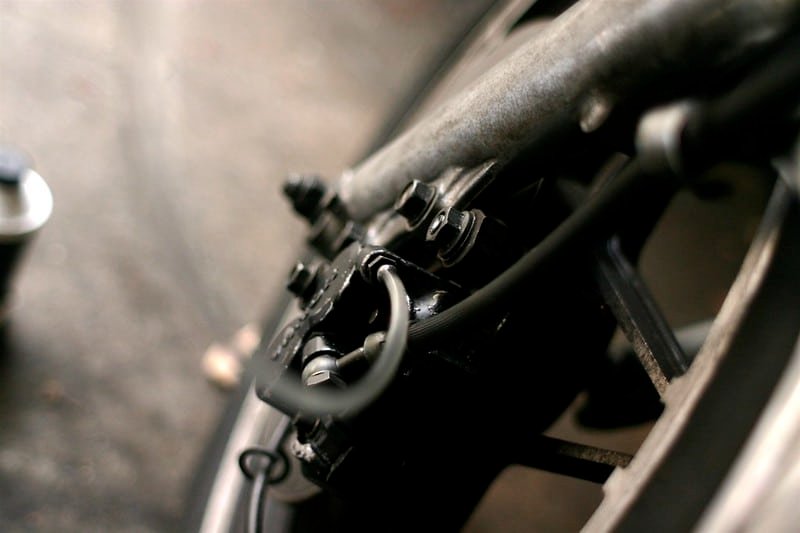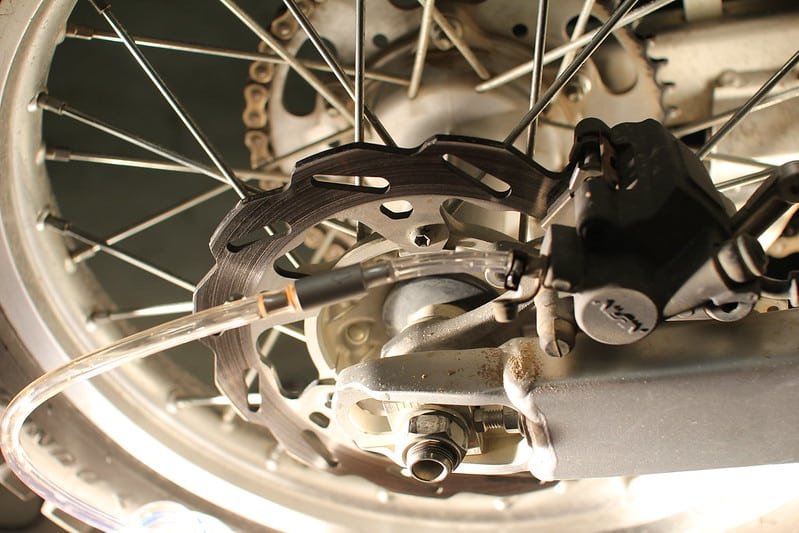Have you ever had a dry motorbike brake fluid reservoir and wondered how to revive your brakes? The process of bleeding motorcycle brakes from empty might seem daunting at first, but fear not!
Today, we will not only answer the main question at hand but delve into the intricacies of the procedure, providing you with a step-by-step walkthrough and valuable insights into the world of brake maintenance.
Bleeding Motorcycle Brakes from Empty
Bleeding your motorcycle brakes is a critical aspect of maintenance, especially when faced with the challenge of an empty brake fluid reservoir.
The brake system relies on hydraulic pressure to function optimally. Air in brake lines may lower this pressure, reducing braking performance or causing brake failure.
Start with the right tools:
- a brake fluid reservoir
- a length of clear tubing
- a wrench
- a fresh supply of the recommended brake fluid for your motorcycle.
Then, follow the below steps:
- Find the brake caliper and release the bleeder valve using the wrench.
- Connect one end of the transparent tubing to the bleeder valve and immerse the other in brake fluid.
- To prevent air from entering the braking system, immerse the tubing.
- To remove air from the brake lines, steadily pump the brake lever or pedal with the reservoir cover open.
- It might take numerous attempts to get clear brake fluid flowing through the tube.
Key Aspects of Bleeding Motorcycle Brakes from Empty:
- Understanding Brake Fluid Types
When bleeding your motorcycle brakes, it’s crucial to use the right type of brake fluid recommended by the manufacturer. Brake fluids come in different specifications, such as DOT 3, DOT 4, and DOT 5. Using the wrong type can lead to brake system damage and compromised safety.
- Brake Bleeding Sequence
Motorcycles with dual front brakes or linked brake systems may require a specific bleeding sequence. Refer to your motorcycle’s service manual to identify the correct order for bleeding each brake caliper. Following the correct sequence ensures the removal of air from the entire brake system.
- Importance of Brake Fluid Quality
Brake fluid is hygroscopic, meaning it absorbs moisture over time. Contaminated brake fluid can lead to corrosion within the brake system and reduce its effectiveness. Regularly check the condition of your brake fluid and replace it according to the manufacturer’s recommendations.
- Proper Use of Brake Bleeder Kits
Investing in a quality brake bleeder kit can simplify the bleeding process. These kits often come with a hand pump, making it easier to create a vacuum and remove air from the brake lines. Follow the kit instructions for optimal results.
- Checking for Leaks
After bleeding the brakes, inspect the entire brake system for any signs of leaks. Leaks can compromise the brake fluid level and reintroduce air into the system. Address any leaks promptly to maintain the integrity of the brake system.
- Understanding Brake Bleeding Techniques
Explore different brake bleeding techniques, such as gravity bleeding or pressure bleeding, depending on your motorcycle’s design and your comfort level. Each technique has its advantages, and experimenting with them can help you find the most effective method for your specific motorcycle.
Practical Tips for Bleeding Motorcycle Brakes

- Keep a Bleeder Kit Handy – A brake bleeder kit with a hand pump can be a lifesaver, especially if you frequently perform your motorcycle maintenance.
- Use a Quality Brake Fluid – Opt for high-quality brake fluid to ensure optimal performance and longevity of your brake system.
- Follow the Manufacturer’s Recommendations – Always refer to your motorcycle’s service manual for specific instructions and guidelines related to bleeding the brakes.
- Inspect Brake Lines Regularly – Periodically inspect your brake lines for any signs of wear, damage, or corrosion. Replace damaged lines promptly to maintain the safety of your motorcycle.
Role of Brake Bleeder Kits in Simplifying the Process
Brake bleeder kits are like the superheroes of brake maintenance, making the bleeding process more accessible for motorcycle enthusiasts. These kits typically include a hand pump, clear tubing, and adapters, offering a user-friendly approach to removing air from the brake lines.
Using a brake bleeder kit creates a vacuum, expelling air and ensuring a smoother brake bleeding experience. For novice riders or those new to brake maintenance, investing in a quality brake bleeder kit can make the task less daunting and more efficient. Follow the kit instructions closely, and you’ll find yourself mastering the art of bleeding motorcycle brakes in no time.
Gravity Bleeding vs. Pressure Bleeding – Which Technique is Right for You?
Bleeding motorcycle brakes allow for flexibility in technique, with gravity bleeding and pressure bleeding being two popular options. Gravity bleeding relies on the natural force of gravity to move brake fluid through the system, making it a straightforward method.
On the other hand, pressure bleeding involves using a tool to pressurize the brake fluid reservoir, facilitating a faster and more controlled bleed. Understanding the nuances of each technique empowers you to choose the method that aligns with your comfort level and motorcycle design.
Experimenting with both methods can provide valuable insights into which suits your preferences and yields the best results for your specific motorcycle.
Common Mistakes to Avoid
- Over-tightening the Bleeder Valve – Avoid over-tightening the bleeder valve, as this can damage the threads and make future brake bleeding more challenging.
- Using Old or Contaminated Brake Fluid – Always use fresh, uncontaminated brake fluid to ensure the longevity and effectiveness of your brake system.
- Neglecting Brake System Inspection – Regularly inspect your entire brake system for any issues, including leaks, worn brake pads, or damaged brake lines. Neglecting these checks can lead to safety hazards.
| Motorcycle Brand | Recommended Brake Fluid Type | DOT Specification |
|---|---|---|
| Honda | Honda DOT 3 or DOT 4 | DOT 3 or DOT 4 |
| Yamaha | Yamalube DOT 3 or DOT 4 | DOT 3 or DOT 4 |
| Harley-Davidson | Harley-Davidson DOT 4 | DOT 4 |
| Kawasaki | Kawasaki DOT 3 or DOT 4 | DOT 3 or DOT 4 |
| Suzuki | Suzuki DOT 4 | DOT 4 |
| BMW | BMW DOT 4 | DOT 4 |
| Ducati | Ducati Performance DOT 4 | DOT 4 |
Addressing Common Brake Bleeding Challenges
While bleeding motorcycle brakes is a routine maintenance task, challenges may arise. Common issues include a spongy brake lever, inconsistent brake feel, or difficulty achieving a steady flow of brake fluid. This section explores troubleshooting tips to address these challenges effectively.
From double-checking the bleeder valve tightness to ensuring the brake fluid reservoir remains adequately filled, understanding how to troubleshoot common problems enhances your overall brake maintenance proficiency.
By recognizing and resolving issues promptly, you’ll not only improve your brake bleeding skills but also contribute to a safer and more reliable motorcycle braking system.
FAQs
Final Words
Bleeding motorcycle brakes from empty may seem like a daunting task, but armed with the right knowledge and tools, it becomes a manageable aspect of regular motorcycle maintenance.
By understanding the key aspects, following proper techniques, and avoiding common mistakes, you can ensure that your motorcycle’s braking system performs optimally, providing you with a safe and enjoyable riding experience. Remember, when in doubt, consult your motorcycle’s service manual or seek professional assistance to guarantee the best results.
